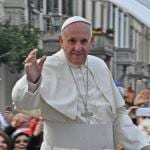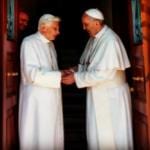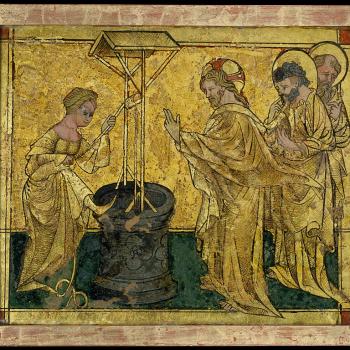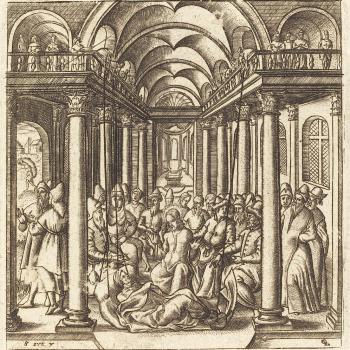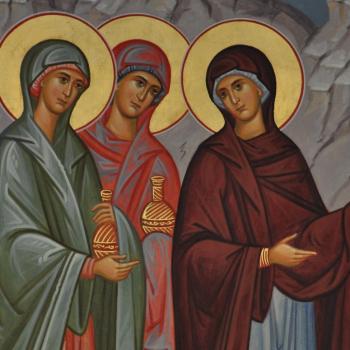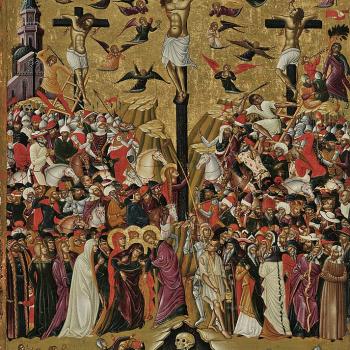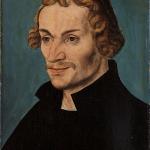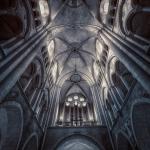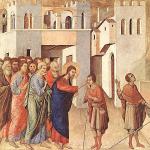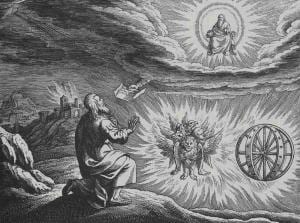
Many of beliefs and teachings expressed by Jewish mystics in the first few centuries of the common era were shared by many Christians. This is because the two were still interconnected, even if they were slowly moving towards mutual independence. Christians were interested in what the Jews believed, but they also knew that they had to interpret what they received from the Jews within a hermeneutic which included the coming of Jesus Christ and the Gospel message.
To properly understand the New Testament, and what its writers believed and understood, requires us to understand the immediate context of the writers of the New Testament. The writers were mostly Jews, with Jewish beliefs and practices which were being transformed because of their belief in Jesus. Certainly Gentile converts brought in new ideas, new thought patterns, to the Christian faith, but they did do so in a way which entirely rejected the basic Jewish paradigm from which the Christian faith emerged. For centuries, Jewish mystical literature fascinated many Christians, which is why educated Christians not only copied such mystical texts, they expanded upon them, creating a vast body of pseudepigraphic literature, some of which came from Jewish writers, and some which came from Christians.
Perhaps one of the most interesting Jewish mystical traditions which emerged in the earliest centuries of the common era was that of the Merkabah beliefs and practices, the tradition explaining and engaging mystical ideas associated with the Great Chariot of God (Merkabah) as recorded in the vision of Ezekiel (and other Old Testament narratives, such as those of Enoch, Elijah and Isaiah). This tradition suggested that through intense spiritual preparation and struggle, one can experience mystical world, the throne of God, and with it, the various levels or dwellings or palaces or mansions or halls (hekhalot) of the divine world (often in and through a meditative or trance-like state). As Joseph Dan indicated, we can trace this tradition back to the first century, even if the texts which we have were written down much later (sometimes several centuries later, such as the 5fh century work of III Enoch):
The first mystics contemplated a visionary experience devoted to the divine heikhalot (palaces) and the merkavah (the divine chariot). Though this movement can be traced to the circle of Rabbi Aqiba in the first half of the second century C.E., the heikhalot and merkavah texts that have reached us were written much later. [1]
G. Vadja, discussing this tradition, understood it was connected with and was a part of the greater Apocalyptic tradition of the time, though its emphasis tended to be less eschatological than other Apocalyptic texts:
It is undeniable that there exists a certain continuity between the apocalyptic visions (i.e., of the cataclysmic advent of God’s Kingdom), and documents of certain sects (Dead Sea Scrolls) and the writings, preserved in Hebrew, of the “explorers of the supernatural world” (Torde Merkava). The latter comprise ecstatic hymns, descriptions of the “dwellings” (hekhalot) located between the visible world and the ever-inaccessible divinity, whose transcendence is paradoxically expressed by anthropomorphic descriptions consisting in inordinate hyperboles (Shi`ur qoma, “Divine Dimensions”).[2]
Likewise, P. Alexander:
The Merkabah texts concentrate overwhelmingly on the mysteries of heaven and the description of God’s throne: they show little interest in eschatological themes such as the last judgment, the resurrection of the dead, the messianic kingdom, and the world to time, all of which figure in classic apocalyptic. The differentiation is a matter of emphasis.[3]
What was eventually written down in the Merkabah was the description of the experience of the mystic, the journey they made through the various halls of heaven before they reached the throne of God. In them, they are shown to have encountered many angels, whose names were written down in the texts because they were often the guards at the entrances to the various levels (or mansions or halls) which one must get through in order to reach the throne of God. The accounts indicated the passwords or signs that were used to get through the various angelic guards, the experience the person had before the throne, and also gives various hymns which came as a result of their experience which could and should be used by their disciples so that they could have a similar mystical experience. There is a sense that the hymns themselves, when sung in repetition, help those who chant them to enter a trance state, and it is in that state they are able to make their spiritual journey. The texts (and the oral tradition behind them) offered explanations to various difficult Scriptural texts, such as how to interpret the story of creation in Genesis, what the vision of Ezekiel represented, and how the Song of Songs itself was best understood. These were the Scriptural texts which early Rabbinic tradition recognized as being difficult to understand and suggested that only those prepared for them, those who were spiritually ready and attuned to the mystical realm, were ready to study them, indicating an element of caution but also some acceptance to what developed within the Merkabah tradition. For the point of the tradition was to present a sense of the spiritual cosmology which is founded upon and is also the foundation for Scripture, as well as offering a guide by which those who were ready could be able to go through the heavenly realms:
The body of knowledge of the Merkabah mystic, therefore, comprised a cosmological theory rooted in the spirit plus a practical knowledge of the paths into that realm. The mystic needed to understand how reality was formed of names, words, letters, sounds and numbers. He needed to know the sequence of the heavenly palaces, and their guards. And he needed to know what was expected of him and what was forbidden to him in this world and in that one.[4]
As already indicated above. the cosmology is one which has many mansions or palaces or hallways in the heavens, with each one having its attendants and guards who keep most people from entering and ascending higher. Those who have been given the proper passwords and signs can enter one palace and from there, go on to the next, greater or higher palace, where they will be tested once again, until going through all the palaces, they come to the throne of God itself. The texts help by offering examples of those who have gone through the many mansions, indicating therefore the names of the angels, and the right way to make sure one can truly be welcomed all the way through the mansions and at the throne of God.
What the Merkabah literature maps out seems, in part, to be found in Christian Scripture. The idea of the “prince of the power of the air” (cf. Eph. 2:1-2), though often interpreted as representing Satan and demonic powers, nonetheless can be seen as being connected with the various mansions or palaces which impede our ascent to the throne of God. Likewise, when Jesus mentioned that there are many mansions in heaven (cf. Jn. 14:1-4), Jesus is said to be preparing our place within them, indicating, perhaps, once again, this ancient Jewish cosmological view, with the difference that Jesus would do all that was needed to be done for our sake so that we can ascend through them. This then, would also explain why he said:
If I have told you earthly things and you do not believe, how can you believe if I tell you heavenly things? No one has ascended into heaven but he who descended from heaven, the Son of man (Jn. 3:12-13 RSV).
Jesus could be seen as indicating that he, and no one else, was the true leader who would take us up through the heavens. Others, like Elijah and Enoch, did not descend all the way from the throne of God, and so cannot ascend all the way to it. They can only lead people to some lesser place in the heavenly realms (however exalted it might be). Therefore, if we want a vision of the most exalted place heaven, if we want to experience it, we need to do so with the direction of Jesus, and this is one way to understand the Apocalypse of John, where the visionary is taken by Jesus to the heavenly courts and the throne of God. In that respect, the New Testament has its own Merkabah text, though its revelation goes much further than what is normally found within the tradition.
While the various texts which contribute to the overall Merkabah literature was written down centuries after Christ, the ideas behind them seem to be spreading in Jewish circles before his birth. Mystics often keep their esoteric traditions as oral traditions, and it was only much later, long after they are dead, that their traditions become collected together and written down by later adherents. Through such time, from the inception of a mystical tradition, to the time in which it is written down, there will be developments within that tradition. Thus, it becomes difficult for us to truly go back beyond the written texts and know exactly what was taught and believed in the initial stages of the Merkabah tradition. This is not to say we cannot extrapolate from what we have and try to develop some notions of the original formulations, because we can, but we must always be cautious with the results, knowing the limitations inherent with such an enterprise (it is merely a reconstruction). Nonetheless, despite this, the various written records which have come down to us give us enough of a glimpse of the tradition and what it contains for us to ascertain that Christians and Jews, Christ and Jewish mystics, were often talking about similar things. Yes, there was an important distinction in that Christians believed that Jesus accomplished for us what the Merkabah tradition suggested various mystical sages accomplished for themselves, and Jesus did it in a way which transcended what the Merkabah mystics were able to accomplish. But this commonality meant Christians and Jews could and did interact with each other, and learn from each other, especially when the communities were not entirely separate from each other. And even if Christians believed Jesus was the ultimate guide who did what we could not do for ourselves, this did not mean we did not have to share in the journey, to follow after him, and in doing so, what some of the other Merkabah mystics reiterated could have been of interest to Christians. Thus, when we turn to the desert tradition, it seems that Merkabah ideas were transferred and further Christianized, and ascetic leaders like St. Antony the Great, were similarly guides to the spiritual world which the Merkabah mystics explored. Antony, Athanasius said, was interested in the mansions of heaven:
Antony, however, according to his custom, returned alone to his own cell, increased his discipline, and sighed daily as he thought of the mansions in Heaven, having his desire fixed on them, and pondering over the shortness of man’s life. [5]
Thus, an account Athanasius wrote about Antony could easily be read as a kind of Merkabah experience, with the difference that Jesus prepared the way so that those who would otherwise guard and stop such an ascent through the heavenly mansions did not impede Antony’s ascent, expecting some sort of password from him:
For once, when about to eat, having risen up to pray about the ninth hour, he perceived that he was caught up in the spirit, and, wonderful to tell, he stood and saw himself, as it were, from outside himself, and that he was led in the air by certain ones. Next certain bitter and terrible beings stood in the air and wished to hinder him from passing through. But when his conductors opposed them, they demanded whether he was not accountable to them. And when they wished to sum up the account from his birth, Antony’s conductors stopped them, saying, ‘The Lord has wiped out the sins from his birth, but from the time he became a monk, and devoted himself to God, it is permitted you to make a reckoning.’ Then when they accused him and could not convict him, his way was free and unhindered. And immediately he saw himself, as it were, coming and standing by himself, and again he was Antony as before. Then forgetful of eating, he remained the rest of the day and through the whole of the night groaning and praying. For he was astonished when he saw against what mighty opponents our wrestling is, and by what labours we have to pass through the air. [6]
Such visions, likewise, might be the foundation for the intriguing though disputed notion of the toll houses, the notion that souls after death will be tried and tested in various “toll booths” along the way to heaven. The test, to be sure, was transformed into a question of the moral character of the one trying to ascend to heaven, but the general cosmological notion seems to be similar if not the same.
Likewise, this cosmological understand seems to be the foundation for the Christian interpretation of Psalm 24, a Psalm which is seen to represent what happened when Christ ascended:
Lift up your heads, O gates! and be lifted up, O ancient doors! that the King of glory may come in. Who is the King of glory? The LORD, strong and mighty, the LORD, mighty in battle! Lift up your heads, O gates! and be lifted up, O ancient doors! that the King of glory may come in. Who is this King of glory? The LORD of hosts, he is the King of glory! Selah (Ps. 24:7-10 RSV).
Psalm 24 is often read as the ascension of the incarnate God came as a surprise to the various guards at the various gates which surround heaven. They did not know of the incarnation, and so, when they saw Jesus ascending, it looked like a man was breaking through the gates of heaven. How could it be? Who is it that was coming? Those angels who were with Jesus answered it was the king of glory himself, the Lord; open up, for the throne is his. In the process of opening up the gates of heaven, it is then viewed that Jesus kept the gates open, allowing his followers to come after him if they bear the right sign on them, the seal of baptism (and the purity of soul associated with baptism); no longer would Christians need to have a map of all the inhabitants of the heavenly mansions; no longer would they need to know the names of all the angels. All they needed to do was come in under the mantle of Jesus, and they would be welcome, for the king of glory opened the gates of heaven.
Christians and Jews, therefore, had a similar, indeed, partly shared vision of reality, of the heavenly realms, with the difference between their traditions being the way it was understood one could ascend through them to reach the throne of God. Some Christians thought that what Jewish lore indicated was how things were before the advent of Christ. The Merkabah literature helped explain the stories of Enoch, Elijah and Ezekiel, Isaiah, among many others. They warned of the dangers which lie ahead and why we want to prepare ourselves for the afterlife. And for this reason, many Christians, especially those living in monastic communities which reinforced the mystical dimension of the Christian faith, had an interest in Jewish cosmological visions, copying and preserving various Jewish apocalyptic writings which would have otherwise been lost to the ravages of time. For they, too, like Antony, were interested in the various mansions in heaven, mansions which were encountered in their own internal spiritual journey as they prayed and meditated in their cells. And, like their Jewish counterparts, the monks saw themselves as undertaking the proper spiritual preparation, such as their various ascetic practices, which would allow them to experience the higher spiritual reality. They did not teach their practices to everyone. But they did reveal enough to indicate that Christians could and would work with the Jewish mystical tradition, transforming it, for the sake of Christian spirituality. As many of the important early Christian spiritual movements were shaped by this interdependent relationship with Judaism, even after Christians and Jews separated from each other in more official capacities, it is possible to see that Christians were far more influenced by Judaism than they, in their later fights against the Jews, would like to admit.
[1] Joseph Dan., “Introduction” in The Early Kabbalah. Trans. Ronald C. Kiener (New York: Paulist Press, 1986), 2.
[2] G. Vadja, “Jewish Mysticism” in Understanding Jewish Mysticism: A Source Reader. Ed. David R. Blumenthal (New York: Ktav Publishing House, 1978), 7.
[3] P. Alexander, “3 (Hebrew Apocalypse) of Enoch” in Old Testament Pseudopigrapha Volume 1: Apocalyptic Literature & Testaments. Ed. James H. Charlesworth (New York: Doubleday, 1983),235.
[4] David Blumenthal, “General Conclusion” in Understanding Jewish Mysticism: A Source Reader. Ed. David R. Blumenthal (New York: Ktav Publishing House, 1978), 95.
[5] St. Athanasius, Life of Antony in NPNF2(4): 208.
[6] St. Athanasius, Life of Antony, 213.


